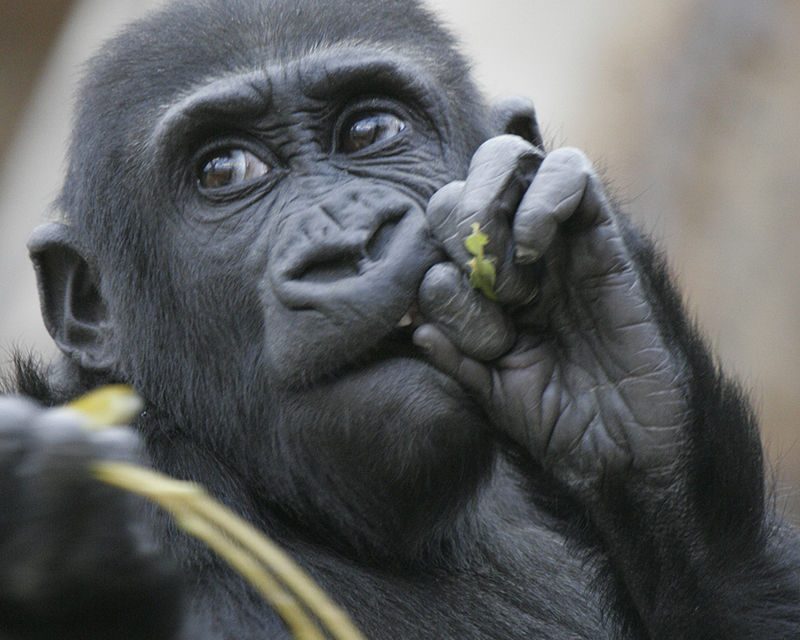A week ago, I took my children to the zoo. A long-time vegetarian, I had always avoided zoos because I assumed that they were cruel to animals. I imagined tiny cages with bars, the kind you see in picture books from fifty years ago. My children were insistent, however. They wanted to see a zoo first-hand, and several trusted friends insisted that this zoo was a good one. I am always willing to change my mind about moral judgments based on good evidence. So we went.
The zoo (which I won’t name) was a very large, well-endowed zoo. Many of the exhibits are very large, with lots of space for the animals to move around, and enclosures that more closely-resemble their natural habitats. Not all of the animals, however, benefitted from new enclosures. Though many of the big cats had been moved, several tigers, pumas, and snow leopards were still in tiny concrete enclosures, pacing. My children, without any prompting from me, noted that the tigers especially “looked sad.” The worst, though, were the apes. Oranguatans, chimps, and gorillas were kept in tiny spaces, with concrete floors and a few rubber tire swings. We watched them morosely, their face pressed to the glass. The silverbacks, like the tigers, seemed restless, pacing back and forth. When a few schoolboys banged on the glass, one gorilla banged the glass back, very aggressively. My friend told me that once when this happened, the glass shattered at the massive strength of the silverback.
It is obviously sad to see such magnificent creatures so far from their natural environment. Morally, we might say that the purpose, the telos of the animal is not being fulfilled. And there is something so obviously cruel about such large creatures, who in the wild have such wide ranges, confined to such tiny enclosures, unable to do anything that nature has hardwired it to do. The creature, which has its own unique dignity, is being treated as an object, a thing to be gaped at, to satisfy only the pleasures of the human spectators.
A friend asked if I would feel differently if all the enclosures were built larger and designed to more closely simulate the natural environment. My response is that, while better enclosures solve some problems, they certainly don’t solve others, the largest among them being that the creatures, for the most part, are still enclosed purely for the pleasure of looking at them and presumably for making a profit. Obviously there are exceptions, such as animals that are handicapped or are being rehabilitated. But we kid ourselves if we think zoos only have such animals. And this is my biggest problem with zoos –that they are largely (though not purely) self-serving. They encourage us to want to come to zoos, not to protect threatened habitats, not to develop awe and reverence for creatures that we would never otherwise see, like the snow leopard.
I watched the reaction of my own family as well as the other adults and children around me as I went through the zoo. While there were certainly some ooohs and aaaahs, I failed to see how habits of conservation and reverance were being developed in the zoo attendees. Though several signs mentioned that some habitats (e.g. the oranguatan’s) were so threatened that within a few decades, these animals might exist only in zoos, the implied message is that we need not really worry. After all, why should we care if they exist in the wild if we can see them in the zoo?
Children would hold out food for some of the animals, bang on their cages, and shout at them. I watched tired parents and children give barely a cursory glance at a tiger, or a bobcat, or a monkey. I saw children complaining because animals were too far away or “not doing anything.” Nothing in the structure of the zoo teaches children that these are wild animals who have a purpose other than our pleasure.
Does this mean I am categorically-opposed to zoos? Obviously, there is a lot of necessary work that zoos do like breeding endangered animals, vital research, and rehabilitation. These good purposes ought to be put in more of a central place in a zoo’s mission. Zoos ought to do more to consciously habituate (note I did not say merely “educate”) people in conservationism. Telling people that conservation is important is not enough. Habituating people is key. Seeing firsthand the effects of deforestation in Sumatra, or demonstrating the effect of climate change on the arctic might be a start, with clear demonstrations of how our activity (burning fossil fuels or buying certain furniture) plays a role in the damage. The number of exhibits should be reduced with a set-up to encourage longer and more reverential viewing of animals, with more active participation among the staff to educate onlookers about the animals’ natural behavior. And obviously, only animals that cannot continue to exist in the wild should be kept on permanent display.
Zoos are such a huge part of our culture and of childhood experiences in our country. Nevertheless, we ought to be clear-sighted about the harm they may do, and how they may cause us to fail in our duty to protect the environment and all of her creatures.






Hi Beth,
Thanks for this insightful and prophetic post. I have a book recommendation for you. You may already know it but if not I think it will really resonate with you. https://www.amazon.com/Thought-Exist-Wild-Awakening-Nightmare/dp/0972838716
Thanks, Beth, for this challenging and insightful post. We’ve been members of the San Diego Zoo & Safari Park for 8 years, and my perspective is more positive than yours overall, but I do share your concerns. It seems to me that in Laudato Si, we’re pressed more and more to think our ourselves as interdependent and responsible for creation. Sometimes we can foster that understanding through wilderness hikes, camping, or other outdoor experiences. But for many, zoos are a piece of that too. I think our zoo does a good job of the education piece. My daughter’s favorite summer camp experience is the zoo camp and she comes back with enthusiasm for stories of the giraffes she fed and the snakes she held and what she learned about how the condors were saved from extinction. It isn’t everything, but it is something. In a context where many citizens lack basic science literacy, and church goers are often the worst (think for example of the anti-science claims among religiously motivated doubters of evolution), we need science museums and zoos as a part of the cultural and institutional landscape of social formation. But we need to do them well and to create more just animal habitats and more effective educational opportunities for children of all socioeconomic backgrounds. I am fortunate to have had the opportunity to do a gorilla trek in Rwanda and a safari in Kenya, and it was life changing. But not everyone can afford those opportunities, not to mention the carbon footprint of international travel. I think there has to be some middle ground where we can meet on this, where we acknowledge that some zoos are doing a poor job and others are doing a better job.
Time had an interesting recent article raising these questions:
http://time.com/4672990/the-future-of-zoos/
I am sympathetic to much of what you say here, especially now that in my DC life, one of my usual jogging routes takes me right through the National Zoo – which I think has made me more viscerally aware of the strange-ness of confining animals like this. I did think that the poor behavior of children and parents, and their tendency to look for features of entertainment culture at zoos, isn’t really the zoo’s fault. I always see children and parents that are like this, but I also see ones who are experiencing a sense of wonder at encountering these animals and who are educating themselves via all the information the zoo supplies. In the Time article, they suggest that future zoos may in fact look more like safaris, where animals roam and the people move around the habitat in confined spaces.
There’s a solution to this problem which is already being implemented in some cases. Zoos should be limited to rehabbing and releasing orphaned wildlife, serving as animal hospitals, and as long term care for non-releasable wildlife.
This sets the best example for kids. The lesson should be, serve the wildlife, instead of imprisoning them for your own entertainment. I see no need to rationalize the later.
I actually live in such a place, our house. My wife has been an avid wildlife rehabber for a dozen years, and I serve as her helper, building cages and such. It’s quite an experience living with wildlife, try it sometime! Bird season is upon us, and it will be crazy here shortly.
I assure you there is an inexhaustible supply of wild critters in trouble who need our help, especially as we bulldoze over their habit at a breathtaking pace (twice as many humans in America in my lifetime).
If you’re ever in Florida, check out Homosassa Springs Wildlife State Park. https://www.floridastateparks.org/park/Homosassa-Springs
They specialize in Florida wildlife. It’s a wildly popular park, more crowded than Disney (the only drawback). They do have a hippo left over from an earlier era, but I believe most of the animals are native to Florida and in need of assistance.
If you’ve never seen a Manatee, this is a great place for that. The park has an underwater tank inside of a spring which you can easily walk right in to. The manatees come frequently and are in full view only an inch outside the underwater glass windows. Looks just like this….
http://kids.nationalgeographic.com/content/dam/kids/photos/animals/Mammals/Q-Z/west-indian-manatee-group.jpg
the tigers especially “looked sad.” silverbacks, like the tigers, seemed restless
Well at least these statements are qualified by “looked” and “seemed” since in reality we really have no idea how these animals feel or what they think. We have just anthropomorphized these animals. So I disagree that a zoo is by its very nature cruel.
And operating it at a profit has no bearing on its cruelty. A profit merely ensures its continued existence and is some evidence that it might be contributing to human flourishing.